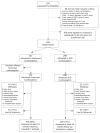A randomized trial of the intrauterine contraceptive device vs hormonal contraception in women who are infected with the human immunodeficiency virus
- PMID: 17689627
- PMCID: PMC2730754
- DOI: 10.1016/j.ajog.2007.03.031
A randomized trial of the intrauterine contraceptive device vs hormonal contraception in women who are infected with the human immunodeficiency virus
Abstract
Objective: The purpose of this study was to determine whether the intrauterine contraceptive device (IUD) is effective and safe among women who are infected with the human immunodeficiency virus (HIV).
Study design: We randomly assigned 599 postpartum, HIV-infected women in Zambia to receive either a copper IUD or hormonal contraception and followed them for at least 2 years.
Results: Women who were assigned randomly to hormonal contraception were more likely to become pregnant than those who were assigned randomly to receive an IUD (rate, 4.6/100 vs 2.0/100 woman-years; hazards ratio, 2.4; 95% CI, 1.3-4.7). One woman who was assigned to the IUD experienced pelvic inflammatory disease (crude rate, 0.16/100 woman-years; 95% CI, 0.004-868); there was no pelvic inflammatory disease among those women who were assigned to hormonal contraception. Clinical disease progression (death or CD4+ lymphocyte count dropping below 200 cells/microL) was more common in women who were allocated to hormonal contraception (13.2/100 woman-years) than in women who were allocated to the IUD (8.6/100 woman-years; hazard ratio, 1.5; 95% CI, 1.04-2.1).
Conclusion: The IUD is effective and safe in HIV-infected women. The unexpected observation that hormonal contraception was associated with more rapid HIV disease progression requires urgent further study.
Figures






References
-
- World Health Organization. Maternal mortality in 2000: estimates developed by WHO, UNICEF and UNFPA. Geneva: WHO Press; 2004.
-
- Khan KS, Wojdyla D, Say L, Gulmezoglu AM, Van Look PF. WHO analysis of causes of maternal death: a systematic review. Lancet. 2006;367:1066–74. - PubMed
-
- UNAIDS. Joint United Nations Programme on HIV/AIDS: 2004 report on the global AIDS epidemic: 4th global report. Geneva: WHO Press; 2004.
-
- Central Statistical Office [Zambia], Central Board of Health [Zambia], and ORC Macro. Zambia demographic and health survey 2001–2002. Calverton (MD): Central Statistical Office, Central Board of Health, and ORC Macro; 2003.
-
- World Health Organization. Strategic approaches to the prevention of HIV infection in infants: report of a WHO meeting; Morges, Switzerland. 20–22 March 2002; Geneva: WHO Press; 2002.
Publication types
MeSH terms
Substances
Grants and funding
LinkOut - more resources
Full Text Sources
Other Literature Sources
Medical
Research Materials

